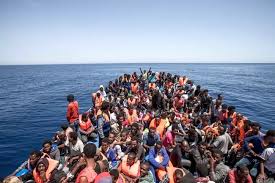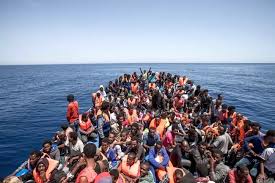
In what constitutes the continent’s biggest wave of mass migration since the aftermath of the second world war, more than a million people have now reached Europe through irregular means in 2015, says that International Organization for Migration.
The IOM said that till 21 December, 2015, 816,752 refugees arrived by sea in Greece out of a total influx of 1,005,504 arrivals. With much smaller figures for Spain, Malta and Cyprus, a further 150,317 arrived by sea in Italy. A total of 34,215 immigrants had crossed by land routes, such as over the Turkish-Bulgarian border.
There has been an overall increase of four times in the figure compared to 2014’s figures where the Syrians fleeing their country’s civil war accounted for the majority of the refugees. The other significant national groups comprised of people fleeing the war zones of Afghanistan, Iraq and Eritrea.
However the International Organization for Migration claims that the European surge of refugees was manageable compared to the far greater numbers that went into the Middle East. It has been estimated that more than 2.2 million Syrian refugees live n Turkey alone.
One fifth of the total population of Lebanon is comprised of the 1.1 million Syrian immigrants and refugees. One tenth of the total population of Jordan is made up by some 633,000 Syrian refugees.
One of the causes of Europe’s migration crisis is the denial of basic rights to refugees in the Middle Eastern countries where almost all Syrians do not have the right to work. To claim the rights bestowed on them by the 1951 UN refugee convention, refugees who have lived for several years in legal limbo are now coming to Europe.
“In Jordan, life is so difficult. There’s no [legal] work. I can’t go to university. There’s no hope. And in Turkey it’s the same thing: no work and no hope,” ‘The Guardian’ reported quoting Nemer, a 24-year-old Syrian student, minutes after landing this week on the Greek island of Lesbos.
Other refugees are fleeing directly from the war zones themselves. The news paper quoted Aruba al-Rifai, a 44-year-old civil servant from the outskirts of Damascus who arrived on Lesbos earlier this week having come straight from Syria as saying: “The bombs are getting worse, and it’s just the beginning. I come to Europe to feel like a human being”.
With just under half of those entering the continent in 2015 doing so by using the island as a staging post between the Greek mainland and the nearby shores of Turkey, Lesbos is now the main refugee gateway to Europe.
The numbers arriving in December are still higher than in June and July, despite the worsening weather and despite a so-called crackdown on Turkey’s people smugglers. Over 15 boats arrived on Lesbos on Monday.
The average number of refugees arriving each day across the Greek islands in December is 3,338 which were lower than the October peak of 6,828, but far higher than July’s 1,771.
The data that was presented by the IOM is an addition to the different and sometimes contradictory figures being used to quantify the European migration crisis. The other sources of such data include the UN refugee agency, Frontex - the EU border agency and Eurostat - the EU’s statistics agency.
(Source:www.theguardian.com)
The IOM said that till 21 December, 2015, 816,752 refugees arrived by sea in Greece out of a total influx of 1,005,504 arrivals. With much smaller figures for Spain, Malta and Cyprus, a further 150,317 arrived by sea in Italy. A total of 34,215 immigrants had crossed by land routes, such as over the Turkish-Bulgarian border.
There has been an overall increase of four times in the figure compared to 2014’s figures where the Syrians fleeing their country’s civil war accounted for the majority of the refugees. The other significant national groups comprised of people fleeing the war zones of Afghanistan, Iraq and Eritrea.
However the International Organization for Migration claims that the European surge of refugees was manageable compared to the far greater numbers that went into the Middle East. It has been estimated that more than 2.2 million Syrian refugees live n Turkey alone.
One fifth of the total population of Lebanon is comprised of the 1.1 million Syrian immigrants and refugees. One tenth of the total population of Jordan is made up by some 633,000 Syrian refugees.
One of the causes of Europe’s migration crisis is the denial of basic rights to refugees in the Middle Eastern countries where almost all Syrians do not have the right to work. To claim the rights bestowed on them by the 1951 UN refugee convention, refugees who have lived for several years in legal limbo are now coming to Europe.
“In Jordan, life is so difficult. There’s no [legal] work. I can’t go to university. There’s no hope. And in Turkey it’s the same thing: no work and no hope,” ‘The Guardian’ reported quoting Nemer, a 24-year-old Syrian student, minutes after landing this week on the Greek island of Lesbos.
Other refugees are fleeing directly from the war zones themselves. The news paper quoted Aruba al-Rifai, a 44-year-old civil servant from the outskirts of Damascus who arrived on Lesbos earlier this week having come straight from Syria as saying: “The bombs are getting worse, and it’s just the beginning. I come to Europe to feel like a human being”.
With just under half of those entering the continent in 2015 doing so by using the island as a staging post between the Greek mainland and the nearby shores of Turkey, Lesbos is now the main refugee gateway to Europe.
The numbers arriving in December are still higher than in June and July, despite the worsening weather and despite a so-called crackdown on Turkey’s people smugglers. Over 15 boats arrived on Lesbos on Monday.
The average number of refugees arriving each day across the Greek islands in December is 3,338 which were lower than the October peak of 6,828, but far higher than July’s 1,771.
The data that was presented by the IOM is an addition to the different and sometimes contradictory figures being used to quantify the European migration crisis. The other sources of such data include the UN refugee agency, Frontex - the EU border agency and Eurostat - the EU’s statistics agency.
(Source:www.theguardian.com)





